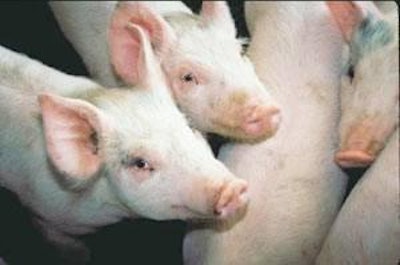
It is well known that major feed ingredients in swine diets are also major sources of energy and protein which contribute greatly in determining feed cost. Major sources of energy in such diets are usually composed of grains such as corn, wheat, barley, sorghum, and by-products such as dried distillers grains with solubles. Soybean meal and its variants have traditionally been the most popular plant protein sources; however, other by-products are also available.
Although these feed ingredients provide good sources of nutrients, their full potential is not always maximized, especially by young animals. Most of these ingredients contain non-starch polysaccharides or anti-nutritional factors (ANFs) such as xylans, galactosides, mannans, glucans and galactomannans that are not only resistant to endogenous enzymes produced by animals but also contribute to the production of unwanted compounds. Such conditions can lead to a reduction in feed digestibility and eventually growth performance (Table 1).
Economic implications
Dietary exogenous enzymes capable of degrading non-starch polysaccharides may indeed benefit the swine industry. It is generally known that the non-starch polysaccharide content is negatively correlated with energy digestibility of feed diets.
Such improvements in the feeding value of both traditional and alternative raw materials would have obvious economical implications. Currently, there have been numerous commercial enzyme products available ranging from single preparation enzymes which act on only one substrate to multi-enzymes which act on a number of substrates. However, due to the inconsistent supply and availability of raw materials, the latter may be more convenient to use. Nonetheless, in order to justify enzyme use, these supplements must have high enzymatic activity against the target substrate, be stable under different feed processing conditions, and be cost effective. In this regard, studies have been conducted to determine the consistency of multi-enzyme preparations in targeting a wide variety of substrates found in both traditional and alternative raw materials.
Consistent results
Corn and soybean meal are the most common raw materials used in conventional swine diets. Although these traditional ingredients are excellent sources of energy and nutrients, they still contain ANFs even after feed processing, especially soybean meal (Hartwig et al., 1997). These ANFs cannot be degraded by endogenous enzymes and can adversely affect piglet growth. For example, ANFs found in soybean meal are capable of raising the production of flatulence-producing compounds by hind gut microorganism and decreasing nutrient digestibility of feed (Table 2). Researchers at Texas Tech University and Illinois University (Kim et al., 2003) in a series of experiments characterized the efficacy of a multi-enzyme preparation which selectively targets ANFs found in corn-soy diets on growth performance and nutrient digestibility.
Experiment 1 was conducted using a total of 108 pigs at 21 days of age fed one of three experimental diets based on a three phase feeding program (1, 2, and 2 weeks respectively for each phase) assigned to one of three treatment diets containing 0 (control), 0.1 and 0.2 percent of the multi-enzyme preparation (Endopower; Easy Bio Systems, Inc.). Results showed that using the multi-enzyme preparation at 0.1 percent improved gain to feed ratio by 9 percent (Table 3).
The second experiment included 10 gilts at 21 days of age fitted with simple T-cannulas at the terminal ileum in order to evaluate the efficacy of the multi-enzyme preparation on nutrient digestibility. Pigs were fed identical diets until phase two and were fed diets with (0.1 percent) or without multi-enzyme preparation during phase three period.
Results indicate that the multi-enzyme utilized in the study improved apparent ileal digestibility of GE, lysine, threonine and tryptophan (Table 4). Finally, in order to further characterize the efficacy of the multi-enzyme preparation on gut morphology and growth performance, a total of 90 pigs at 21 days of age were fed identical diets up to phase two and were then fed diets with (0.1 percent) or without multi-enzyme supplementation.
Consistent with previous results, addition of the multi-enzyme improved gain to feed ratio of nursery pigs (Table 3). Moreover, concentrations of both raffinose and stachyose (ANFs) concentrations in the small intestine were lower and average villi height was greater for piglets fed diets supplemented with the multi-enzyme preparation).
Dried distillers grains with solubles or DDGS, has been gaining much attention as both an energy and protein source in swine diets. However, the low digestibility and nutrient variability of this feedstuff hinders its usage in conventional swine diets. With the rise in the price of corn, maximizing the utilization of such by-products is vital. In addressing this concern, a study was recently conducted by researchers at JBS United, Inc. (Spencer et al., 2007) to determine the efficacy of a multi-enzyme preparation in piglet diets with corn-DDGS included at 30 percent. The study involved a total of 300 piglets weighing 9.0 kg at around 31 days of age randomly allotted by weight to one of three treatment groups. The first group was fed a conventional corn-soy diet (61.5 percent corn and 28.5 percent soybean).
Improved gain to feed ratio
A diet (35.5 percent corn and 24.5 percent soybean) containing 30 percent corn-DDGS without enzyme supplementation and a diet containing 30 percent DDGS supplemented with a multi-enzyme preparation was fed to treatment groups two and three, respectively. Results indicate improved gain to feed ratio. Furthermore, the multi-enzyme preparation utilized in the study allowed for improvements in growth performance of nursery piglets fed diets containing high levels of DDGS.
Other research results have shown that the use of multi-enzyme preparations in barley-based diets containing up to 30 percent wheat-DDGS have also shown positive results in growing pigs (Opapeju et al., 2006). With the current developments in the ethanol industry and consequential rise in the production in DDGS, the use of appropriate enzyme preparations may indeed be an effective tool.
The use of exogenous multi-enzyme supplements in swine diets using both traditional and alternative raw materials has beneficial effects not only on the performance of animals but also to producers by boosting the value of feeds and increasing profits.


.jpg?auto=format%2Ccompress&fit=crop&h=167&q=70&w=250)














